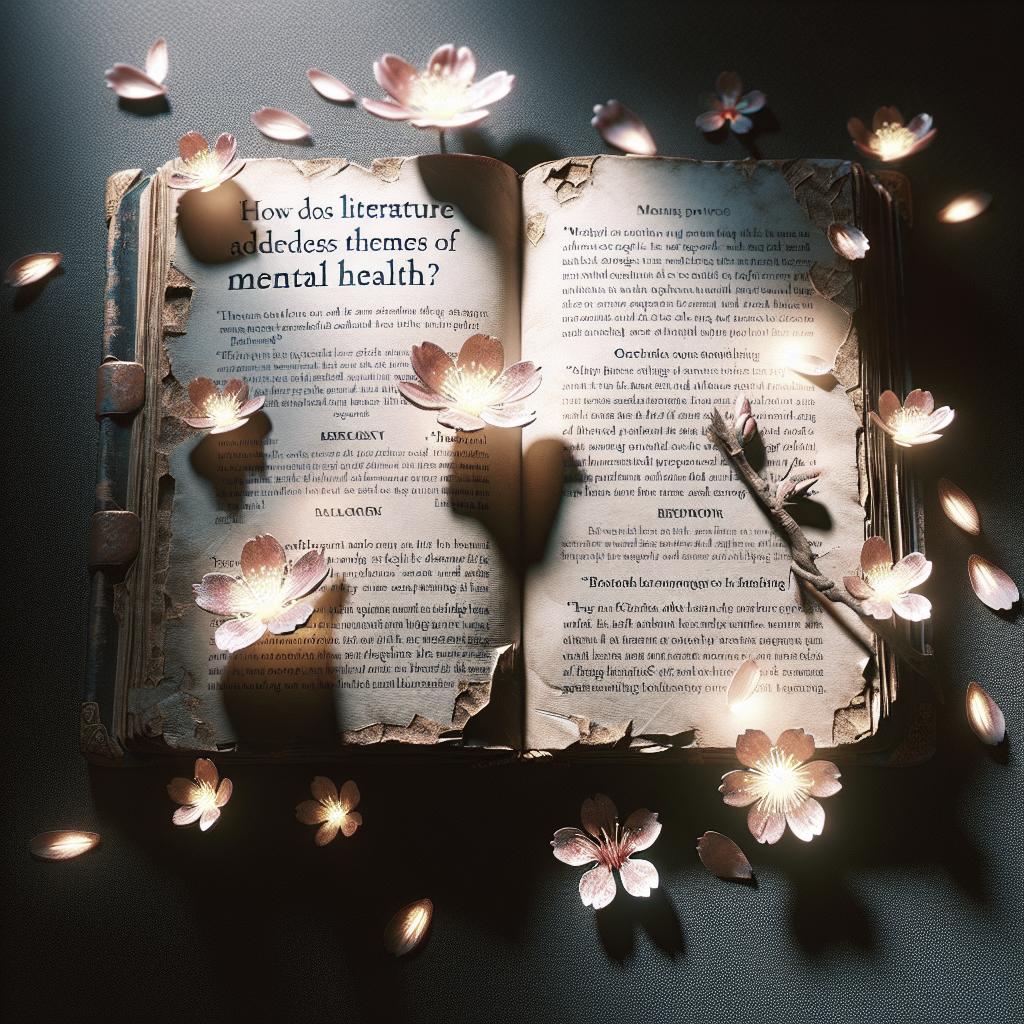The Exploration of Mental Health Themes in Literature
Literature has been a powerful medium to explore and address mental health themes throughout history.
Themes of mental health have found their way into works spanning from the structured diction of the
nineteenth century to the raw, thought-provoking narratives of the twentieth century. This blog post delves
into how mental health has been portrayed over the years, highlighting eras of literary development and
landmark works in this context. We will explore romantic and gothic depictions of mental health, the impact of
societal expectations, and highlight influential writers such as Virginia Woolf and Sylvia Plath. Finally,
we will consider how books themselves can act as a form of therapy, adding another layer to the understanding
of literature’s role in mental health discourse.
Nineteenth Century
General Background
During the nineteenth century, literature began to reflect the changing perspectives on mental health issues.
As understanding slowly evolved, writers began to tackle these themes with a new depth of insight. The era
was marked by dramatic societal changes driven by industrial advancements and social reform, which
inevitably found expression within the arts. Literature became an agent of evolution, continuously
expanding its interpretations of mental health.
Authors of this era often portrayed mental health in binary terms—madness and sanity—with literature becoming a canvas that mirrored the era’s limited understanding of psychology. However, pioneers who delved into this
aspect of human experience with empathy and curiosity paved the way for future depictions that broadened
the narrative complexity of mental health in literature.
The Romantic View
Romantic Madness
Romanticism, spanning the late eighteenth to the mid-nineteenth century, embraced emotion, nature, and introspection. It was within this artistic movement that the concept of “romantic madness” emerged. The romantic poets and writers explored the fine line between genius and madness, often viewing mental turmoil as a precursor to creative brilliance.
Figures like William Blake and Lord Byron eschewed convention, utilizing their works to explore insanity through a lens of beauty and metaphysical query. These perspectives challenged readers to consider the notion that so-called madness could be an inherent aspect of profound creativity, underscoring the romantic belief in the value of authentic, unrestrained emotion.
The Gothic View
Gothic Madness
The gothic genre took a different approach to mental health, often wrapping themes of madness in mystery and terror. Here, mental instability frequently served as a tool to evoke fear and suspense, capitalizing on the prevailing uncertainty surrounding mental health diagnoses. This use of psychological disorder as a narrative device often blurred the lines between the supernatural and psychological realities.
Key works such as Mary Shelley’s “Frankenstein” and Edgar Allan Poe’s tales utilized madness subtly to navigate complex human emotions through dark, foreboding plots. In doing so, gothic literature left indelible marks on cultural perceptions, creating a legacy of psychological intrigue interwoven with fear-inducing storytelling.
Twentieth Century
General Background
With the advent of the twentieth century, literature began to portray mental health issues with unprecedented nuance and empathy. This century was characterized by considerable psychological advancements and increased dialogue around the realities of mental illness. As understanding grew, so too did the depth and breadth of literary representations.
This period saw significant shifts in societal attitudes towards mental health, influenced in part by efforts to destigmatize these conditions. Writers began to explore and dissect their intricacies, often using fiction as a lens to reflect their era’s complexities and providing critical insights into the human psyche.
Shellshock
The horrors of World War I and World War II gave rise to the concept of shellshock, known today as post-traumatic stress disorder (PTSD), which emerged as a recurring theme in wartime literature. Authors wrote candidly about the psychological toll of warfare, exposing the silent suffering endured by returning soldiers.
Classics such as Erich Maria Remarque’s “All Quiet on the Western Front” and Pat Barker’s “Regeneration Trilogy” explored how shellshock disrupted the lives of veterans, acknowledging the intersection of war’s brutality and the enduring struggle of psychological recovery. Through their stark narratives, these works contributed to an evolving understanding and conversation around trauma.
Society and Expectations
Throughout the twentieth century, literature also addressed the oppressive nature of societal expectations on mental health. Often, unrealistic ideals regarding success, gender roles, and personal fulfillment fueled narratives of psychological distress and alienation.
Ray Bradbury’s “Fahrenheit 451” and Aldous Huxley’s “Brave New World” delved deeper into how a conformist society suppresses individuality and impacts mental well-being. Conversely, these narratives also underscored the transformative potential of self-awareness and resistance to societal constraints, positioning literature as an advocate for both introspection and change.
Mental Health in Literature
Virginia Woolf
Virginia Woolf was a literary icon renowned for her exploration of consciousness, identity, and mental instability. Her works, such as “Mrs. Dalloway” and “The Waves,” subtly wove narratives of mental health into complex explorations of human experience, employing stream-of-consciousness techniques to reveal the internal struggles of her characters.
Woolf’s literature remains significant for its intimate portrayal of mental illness and its effects on identity and relationships, crafting a nuanced dialogue on how these subjects resonate in everyday life. Her life, fraught with her own mental health challenges, further influenced her writing, enabling her to explore these themes from a deeply personal perspective.
Sylvia Plath
Sylvia Plath’s body of work is often celebrated – and scrutinized – for its raw portrayal of mental illness. Her semi-autobiographical novel “The Bell Jar” delves into the protagonist’s struggle with depression, exposing the profound isolation and turbulence experienced when battling mental ill-health in a world that often stigmatizes it.
Plath’s fearless confrontation with deeply personal demons in her poetry and prose propelled mental health themes into stark focus, contributing significantly to literature’s role as a mirror and catalyst for change. Her works remain touchstones for empathy and understanding, laying bare her struggles and resonating with countless readers who find solace in her vulnerability.
Mental Health Through Literature
The Books
Books dealing with mental health themes have the power to shape perceptions, challenge stigma, and foster empathy. Over the decades, such works have diversified and expanded, broadening the range of experiences and voices represented. From contemporary narratives like Matt Haig’s “Reasons to Stay Alive” to Elizabeth Wurtzel’s “Prozac Nation,” literature continues to push boundaries, evolving alongside societal attitudes toward mental illness.
These books serve as vital resources for both individuals grappling with mental health challenges and those seeking to understand them, providing avenues for compassion, education, and empowerment. By presenting authentic accounts of struggle and recovery, they underscore literature’s transformative potential as a tool for healing and advocacy.
Books as Bibliotherapy
Bibliotherapy, the practice of using literature to support mental health, highlights the notion that books can heal. This therapeutic approach leverages the therapeutic potential of reading to facilitate emotional well-being and insight. By offering readers curated selections that mirror or challenge their thoughts and feelings, bibliotherapy fosters self-reflection and resilience.
Through the stories of characters and narratives that resonate, bibliotherapy can broaden understanding, enhance self-awareness, and cultivate empathy. It empowers individuals to navigate their emotional landscapes, forging connections and coping mechanisms while illustrating the power of epistolary healing.
Next Steps
| Era | Themes | Authors | Literary Contribution |
|---|---|---|---|
| Nineteenth Century | Romantic and Gothic Madness | William Blake, Mary Shelley, Edgar Allan Poe | Explored madness through beauty and fear |
| Twentieth Century | Shellshock, Societal Expectations | Erich Maria Remarque, Pat Barker | Addressed the psychological impact of war |
| Twentieth Century | Mental Health in Literature | Virginia Woolf, Sylvia Plath | Portrayed the nuances of mental illness |
| Modern | Mental Health Through Literature | Matt Haig, Elizabeth Wurtzel | Books as tools for empathy and healing |


